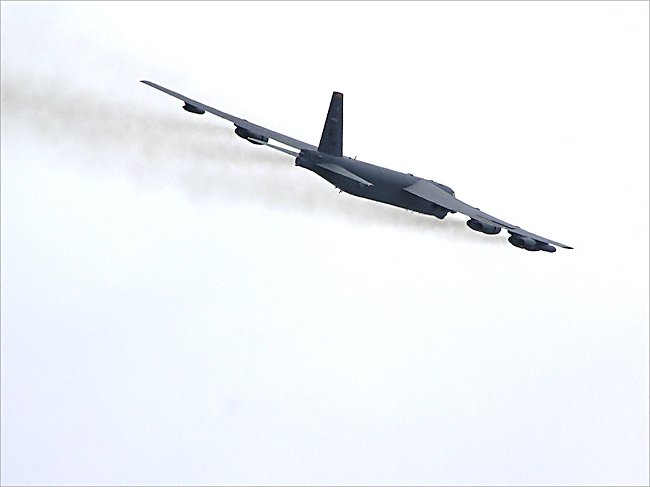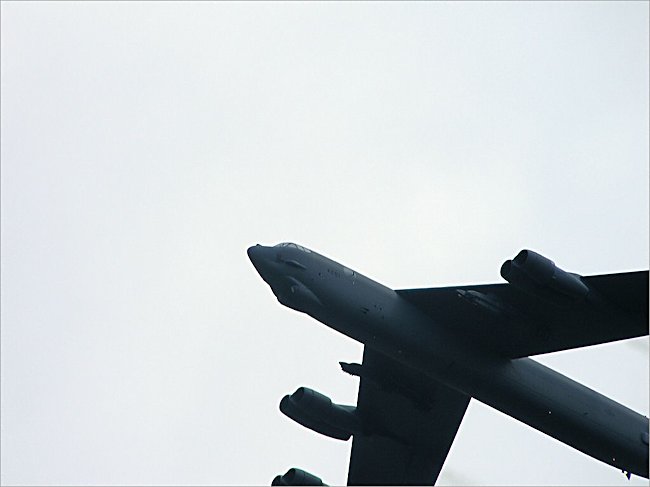Boeing B-52 Stratofortress
The USAF Boeing B-52 Stratofortresses long range strategic heavy Bomber could look after itself. It carried 2 Hound Dog supersonic missiles and bombs. It had a 20 mm radar directed tail turret cannon, Twenty SRAMs or twenty ALCMs (B-52H). It has a crew of five and a top speed of 650 mph. The B-52 bomber has a ceiling of 50,000 feet and a range of 10,000 miles without refuelling. This US Military Bomber is huge. It had a wing span of 185 feet and a length of over 157 feet. It has been in service for over 55 years and can drop an array of munitions including gravity bombs, cluster bombs and precision guided missiles. The B52 has undergone numerous upgrades and weapons improvements to meet the different challenges over the past three decades.
US Army Air Corps started a design competition for a new strategic bomber to replace the B-36. In 1946 their requirements specified that the new bomber must carry a 10,000-pound bomb load, 5,000 miles, be able to cruise at a minimum of 450 mph, at an operating altitude of 35,000 feet. Boeing was awarded the design contract. The test flight in 1952 was successful, and its performance exceeding the original specifications.

The first B-52s were delivered in 1955. Over 740 bombers have been. During the Cold War in the mid 1950s the US had prepared to fight a nuclear war with similar tactics to those used in World War Two. United States of America's nuclear strategic airpower, provided a nuclear umbrella for America and its allies. The idea behind the build up of a nuclear force was to deter war and resolve conflicts on terms favourable to the United States as they were the strongest side.
In 1958 high altitude covert U-2 spy planes reported being fired upon by Russian surface-to-air missiles SAMs and that they got uncomfortably close to the U-2s operating altitude. This prompted SAC to revise tactics for the B-52. It was the first of several major changes. The Boeing B-52 fleet was modified with an improved radar altimeter, a new terrain avoidance radar, modified equipment mounts, increased cooling capacity for sustained low altitude operations, and a strengthening of the aircraft's secondary structures to enable it to penetration enemy air space in all-weathers at 500 feet and survive.

With the change in strategy the production of the B-52 ended in the summer of 1962 but as it was losing its traditional strategic nuclear strike role the Vietnam war began. B-52's were being called upon for bombing support. Experience in this hostile environment and the increased use of SAMs and interceptor jets made the low level penetration role of the B-52 suspect as the predicted casualty rates would be too high. Inter-continental Ballistic Missiles ICBM would be the first response followed by submarine launched trident nuclear missiles with a back up force of 225 B-52, a new short-range attack missile (now called SRAM) and F-111 was the new thinking.
President Carter announced in June 1977 that he intended to extend the life of the B-52 by modifying it to carry a longer range air launched cruise missile. Its penetrator role changed to that of a long range missile launch platform extending the reach of cruise missiles. As its payload could be launched outside SAM infested areas the B-52 bomber extended its operational life yet again.
B-52 bombing strikes were an important part of Operation Desert Storm. B52's flew about 1,620 sorties, B-52s delivered 40% of the weapons dropped by coalition forces while suffering only one non-combat aircraft loss, with several receiving minor damage from enemy action.
From 2 to 3 September 1996, two Boeing B-52H Stratofortress bombers struck Baghdad power stations and communications facilities with 13 AGM-86C conventional air-launched cruise missiles (CALCM) as part of Operation Desert Strike, a 34-hour, 16,000-mile round trip mission from Andersen AFB, Guam, the longest distance ever flown for a combat mission
The B-52's capacity to "loiter" for extended periods over (or even well outside) the battlefield, while delivering precision standoff and direct fire munitions, has been a valuable asset in conflicts such as Operation Iraqi Freedom
These ancient aircraft are used over Afghanistan as part of Operation Enduring Freedom in 2001. the B52 bombers providing the ability to loiter high above the battlefield and provide Close Air Support (CAS) through the use of precision guided munitions, a mission which previously would have been restricted to fighter and ground attack aircraft. The USAF intends to keep the B-52H in service until at least 2040, nearly 80 years after production ended.
The USAF Boeing B-52 Stratofortress superior performance at high subsonic speeds and relatively low operating costs have kept the B-52 in service despite the advent of newer bombers like the Mach-3 North American XB-70 Valkyrie, the supersonic Rockwell B-1B Lancer, and the stealth bomber Northrop Grumman B-2 Spirit. The speed of the B-1 Lancer and the stealth of the B-2 Spirit have only been useful until enemy air defenses were destroyed, a task that has been swiftly achieved in recent conflicts. The B-52 boasts the highest mission capable rate of the three types of heavy bombers operated by the USAF. Whereas the B-1 averages a 53% ready rate, and the B-2 achieved 26%, the B-52 averages 80% as of 2001. When the air defences have been neutralized the b52 is the preferred weapon of choice